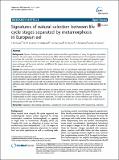Por favor, use este identificador para citar o enlazar a este item:
http://hdl.handle.net/10261/122187COMPARTIR / EXPORTAR:
 SHARE SHARE
 CORE
BASE CORE
BASE
|
|
| Visualizar otros formatos: MARC | Dublin Core | RDF | ORE | MODS | METS | DIDL | DATACITE | |

| Título: | Signatures of natural selection between life cycle stages separated by metamorphosis in European eel |
Autor: | Pujolar, J. M.; Jacobsen, M. W.; Bekkevold, D.; Lobón-Cerviá, Javier ; Jónsson, Bjarni | Palabras clave: | Adaptative decoupling hypothesis Complex life cycles Metamorphosis RAD sequencing Selection |
Fecha de publicación: | 13-ago-2015 | Editor: | BioMed Central | Citación: | BMC Genomics 16: 600 (2015) | Resumen: | [Background]
Species showing complex life cycles provide excellent opportunities to study the genetic associations between life cycle stages, as selective pressures may differ before and after metamorphosis. The European eel presents a complex life cycle with two metamorphoses, a first metamorphosis from larvae into glass eels (juvenile stage) and a second metamorphosis into silver eels (adult stage). We tested the hypothesis that different genes and gene pathways will be under selection at different life stages when comparing the genetic associations between glass eels and silver eels. [Results] We used two sets of markers to test for selection: first, we genotyped individuals using a panel of 80 coding-gene single nucleotide polymorphisms (SNPs) developed in American eel; second, we investigated selection at the genome level using a total of 153,423 RAD-sequencing generated SNPs widely distributed across the genome. Using the RAD approach, outlier tests identified a total of 2413 (1.57 %) potentially selected SNPs. Functional annotation analysis identified signal transduction pathways as the most over-represented group of genes, including MAPK/Erk signalling, calcium signalling and GnRH (gonadotropin-releasing hormone) signalling. Many of the over-represented pathways were related to growth, while others could result from the different conditions that eels inhabit during their life cycle. [Conclusions] The observation of different genes and gene pathways under selection when comparing glass eels vs. silver eels supports the adaptive decoupling hypothesis for the benefits of metamorphosis. Partitioning the life cycle into discrete morphological phases may be overall beneficial since it allows the different life stages to respond independently to their unique selection pressures. This might translate into a more effective use of food and niche resources and/or performance of phase-specific tasks (e.g. feeding in the case of glass eels, migrating and reproducing in the case of silver eels). |
Descripción: | Received: 16 December 2014, Accepted: 6 July 2015, Published: 13 August 2015 | Versión del editor: | http://dx.doi.org/10.1186/s12864-015-1754-3 | URI: | http://hdl.handle.net/10261/122187 | DOI: | 10.1186/s12864-015-1754-3 | ISSN: | 1471-2164 | E-ISSN: | 1471-2164 |
| Aparece en las colecciones: | (MNCN) Artículos |
Ficheros en este ítem:
| Fichero | Descripción | Tamaño | Formato | |
|---|---|---|---|---|
| BMC Genomics 2015, 16 600.pdf | 783,51 kB | Adobe PDF |  Visualizar/Abrir |
CORE Recommender
PubMed Central
Citations
5
checked on 04-may-2024
SCOPUSTM
Citations
18
checked on 03-may-2024
WEB OF SCIENCETM
Citations
17
checked on 24-feb-2024
Page view(s)
291
checked on 07-may-2024
Download(s)
233
checked on 07-may-2024

